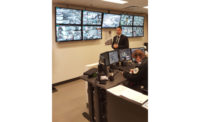Security dealers still may be experiencing losses or plateaus in areas hit hard by the economic recession such as new construction markets, but savvy dealers are seeing increases in other markets, such as video monitoring and verification, mobile applications and services, and personal emergency response systems (PERS). In many cases, successful sales and recurring monthly revenue (RMR) growth is coming from the existing customer base.
Third-party monitoring companies are testaments to the growth happening in certain areas of the marketplace, with many of them investing millions into new staff, infrastructure and facilities in recent years. To keep up with the demand from dealers and end users, third-party monitoring centers are upgrading and expanding their services portfolio in key areas where they expect to see continued growth.
Affiliated Monitoring, Union, N.J., recently moved into its brand new $24 million facility complete with an emergency power plant on site (see related article, “Model Growth: Monitoring Company Builds 80,000-Square-Foot Facility”). Two years ago, EMERgency24, Chicago, moved to new facilities in the Chicago area and just last year, the company opened a fully redundant U.L. listed backup facility for its Chicago location in Waukesha, Wis.
C.O.P.S. Monitoring, Williamstown, N.J., announced its fourth central station location last May in Tennessee and expects to open another in Texas this year. SentryNet of Pensacola, Fla., moved its Greenville, Miss., operations to Memphis at the end of 2011, where it expects to add more than 100 employees over the next year. A $4 million automation technology upgrade is just the start of Rapid Response’s recent investments; the Syracuse, N.Y.-based company is currently in the planning stages of opening a West Coast facility.
All of these upgrades and investments are being driven by the growth that monitoring companies are seeing in several areas. One of the greatest growth areas for third-party monitoring companies right now is PERS monitoring — and according to industry veterans, the growth is not expected to slow down anytime soon.
“PERS is definitely one of the biggest growth markets,” notes Kevin McCarthy, national sales manager at EMERgency 24. “As nursing care and healthcare costs rise, even insurance companies are looking at ways to cut down on premiums and get people out of the hospital in fewer days. With medical reminders, blood pressure monitoring, mobility applications and medication notifications — it’s such a growth opportunity.”
Due to the uptick in PERS that monitoring companies are seeing, many central stations have specially trained operators and separate divisions of the business dedicated to this sector. In addition to medical applications, monitoring companies see the technology expanding to a range of services such as mobile or emergency monitoring for youth, teens and the elderly.
“PERS is big right now and we think there will be a substantial increase, doubling or tripling what we’ve seen so far over the next five years,” predicts Michael Joseph, vice president of operations at SentryNet. Those dealers and integrators that are involved in medical monitoring agree that the current demand for PERS is experiencing a large uptick.
“The need for PERS is huge,” says Bruce Scott, founder and president of Scott Alarm Inc., Jacksonville, Fla. “In the beginning it was very slow, but now it has legs under it and I think it’s one of those things that’s not a main part of the business, but we anticipate will become a very important part of our business.”
Another area of growth that monitoring companies and dealers have seen come to fruition over the past few years is the change in primary communications methods away from POTS lines to long-range radio, Internet and other options. These options are allowing monitoring companies to offer dealers and end users secure communication methods with a wide range of features at premium prices.
“Long-range radio is a great avenue of business for us and long-range radio for fire applications also is popular right now,” describes Chris Mosley, president of Complete Security Systems Inc., Marlboro, N.J. “Everything is RMR driven and we can ask more for these services because they’re more secure and there are more solutions for them on the monitoring side as well.”
Mosley says that when Complete Security Systems started offering long-range radio with a variety of features five or six years ago, it was brought on by the industry. Now, however, he is seeing more tech-savvy consumers become familiar with alternative technologies such as radio and he expects them to start being part of the driving force as well.
“The change in communication methods is one of the most overlooked growth opportunities right now,” believes Morgan Hertel, vice president of operations at Rapid Response. “We are seeing a gigantic influx of GSM-based, two-way audio devices for example.” Hertel adds that from a monitoring company’s standpoint, there is a large investment that has to be made in technology and training to be able to keep up with so many options, and competitive companies have to meet the needs of the dealers — with whatever communication method they choose.
In addition to medical monitoring and the evolution of alarm communications technology, another area where third-party monitoring companies and dealers are seeing growth is in all things video and mobility, including surveillance, verification and remote viewing.
“We have a sharp rise here in residential video,” comments Mosley of Complete Security Systems. “It’s an area of steady growth. We have always pushed it, but now it has become more appealing to the consumer because the price is down and it is being driven by all the smartphone and remote apps that allow people to view video remotely. We can thank technology for opening the door to a lot of this.”
Other dealers are seeing a big boost in video applications that replace on-staff personnel or guard services. “We are seeing an increase in monitored video being used during the course of construction in lieu of afterhours patrol service,” explains Susan Weinstein, vice president, Keyth Security Systems Inc., Highland Park, Ill. In addition, Weinstein adds that Keyth Security Systems has seen significant growth in video verification, particularly as more municipalities implement priority response of verified alarms signals.
Monitoring companies agree that video — particularly remote viewing and verification services — have picked up a lot of speed due to police and local government backing, as well as the availability and ease-of-use of mobile apps. “Video monitoring is hugely growing and enhanced video services seem to be exploding. It’s certainly one of the most dramatic changes we’ve seen in the industry,” says Stanley Oppenheim, president, Affiliated Monitoring. “With the various apps and smartphones available today, it has really come into its own and is booming.”
To keep up with consumer demand for this type of connectivity, many wholesale monitoring companies and even dealers themselves have invested in staff to focus on programs and apps that allow consumers and dealers to manage their accounts from their computers, smartphones or other mobile devices.
“In a nutshell, it’s all about connectivity and mobile everything. That’s crucial to the customer,” Hertel says. “For us that means providing Web and phone applications, emails, interactive voice response and SMS as a bidirectional tool. We receive thousands of texts saying, ‘do dispatch,’ ‘don’t dispatch,’ ‘put the system on test.’ Mobility is a large concept, but clearly Gen X and Gen Y are demanding all these things today.”
With all of these growth areas in monitoring services, it is not surprising that many monitoring companies are upgrading or investing regularly to keep up with the changing landscape of services and technology. While PERS monitoring, video services, mobile applications, and communications technologies are all current hot topics, many monitoring companies also are gearing up for future growth in other areas.
“Use your imagination,” said David Smith, director of marketing and communications at C.O.P.S. Monitoring. “In addition to security, fire and PERS, we believe monitoring companies may eventually include more expanded services: concierge services, responding to various events generated by home automation, and things like that. There are many places we expect to see all this go.”
















